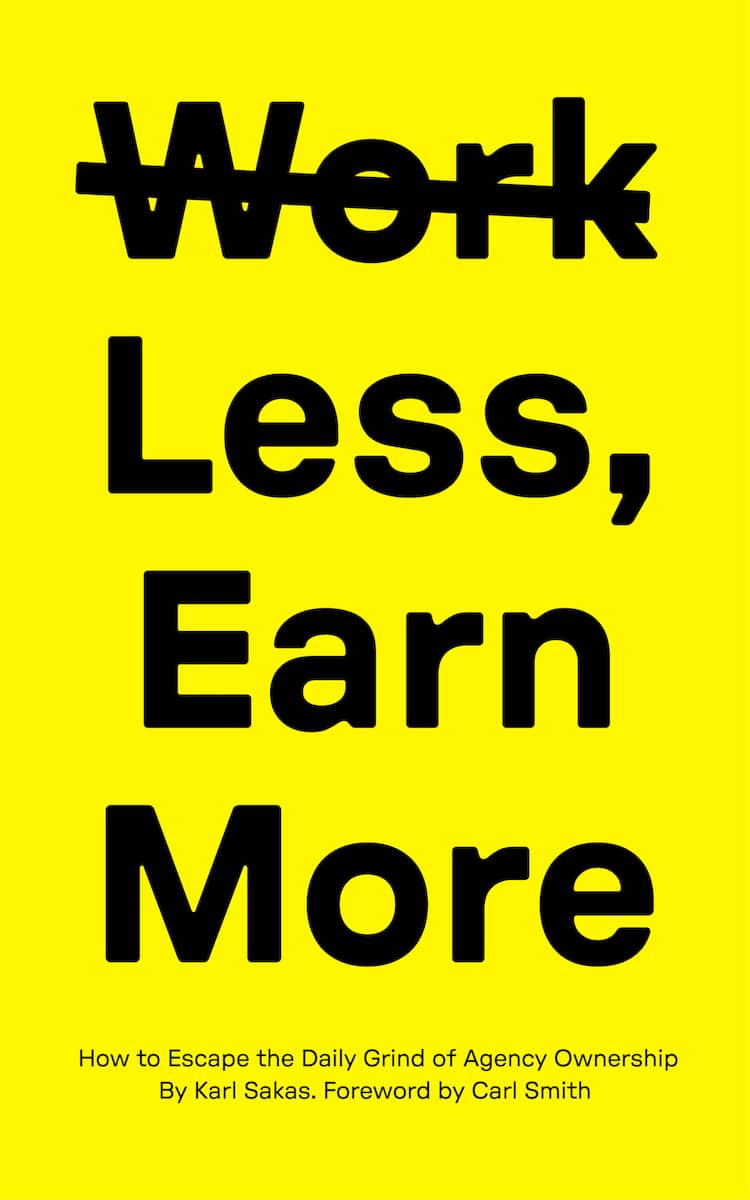Want to transform your marketing agency to meet your financial and life goals? Big changes take time. Fortunately, there are things you can do over the next month to make a faster impact.
From my experience helping hundreds of firms as an agency coach, here are 7 ideas for “quick wins” I’ve seen work at agencies like yours.
- Ask sales prospects to complete a pre-qualification survey before you get on the phone.
- Require clients to complete a pre-kickoff survey.
- Define “swim lanes” for your management team.
- Apply “The 3As” to improve internal agency conversations.
- Implement ongoing client satisfaction surveys.
- Use an ongoing employee engagement tool.
- Read my Made to Lead “pocket guide” in 20-30 minutes.
Let’s take a closer look at each of those. Not all of these will be the right solution for your situation, but I bet at least a couple will give you some quick wins to help you have a better year!
Low Hanging Fruit for Your Digital Agency
The right choice will depend on the underlying problems. Don’t jump to do all of these at once—pick 1-2 to start, and then move on others. Ideally, you’ll delegate these to your management team to lead.
1) Ask sales prospects to complete a pre-qualification survey before you get on the phone.
Have you (or one of your salespeople) gotten on the phone with a prospect who turned out to be a terrible fit? Avoid that common problem by asking clients to complete a pre-qualification survey before you get on the phone.
This can easily help you trim 15-30 minutes from your exploratory calls—and skip calls altogether with people who aren’t a fit. In my pre-intake questionnaire, I ask ~11 questions… but the original version started with just seven questions.
For more on the topic, see my article on sales pre-qualification surveys. (Try it. You’ll love the results!)
2) Require clients to complete a pre-kickoff survey.
Have you ever led a kickoff meeting when you realized client stakeholders weren’t on the same page with each other—or they expected you to do work you never agreed to do? Yeah, me too.
My solution is to do a pre-kickoff survey before the kickoff meeting or call. You’ll ask questions about what they expect, how they define success, and how much time they expect your work will take them each week.
When there’s a mismatch—between your plans, or between stakeholders—you now have an opportunity to address this, before it blows up. Plus, you’ll often identify upsell opportunities for later.
For more on the topic, see my article on pre-kickoff surveys. Pre-kickoff surveys will make your team’s life easier, and eliminate firefighting headaches for you!
3) Define “swim lanes” for your management team.
Do you keep thinking to yourself, “Why are you asking me? That’s your job!”? Are you running into disagreements about who’s in charge of what—or things aren’t happening because no one’s in charge? Are people getting annoyed because other people keep barging into their decisionmaking? It’s time to define “swim lanes.”
Just as a swimming pool has dividers between lanes—so that swimmers stay in their own lane—your agency will benefit from “work” swim lanes. Here are some examples:
1. Don’t ask you for input on a purchasing decision unless it’s over $X.
2. Your PMs can share feedback about design decisions, but the Creative Director makes the final decision.
3. Front-line employees are welcome to ask you for help—but they need to have tried to get an answer from their day-to-day manager first.
They say the definition of insanity is doing the same thing over and over… while expecting a different result. Pausing to define swim lanes can help you stop a range of recurring problems.
For more on the topic, see my article on Swim Lanes at agencies.
4) Apply the 3As to internal agency conversations.
Do you have a tendency to get sucked into solving problems for your team? They’re probably annoyed, too. Fix this by adding a new phrase to intra-company conversations—the “3As”:
- Aware — They just want you to be aware, but they’ll handle it.
- Advise — They want your advice, and then they’ll proceed.
- Actively Involved — They need you to take ownership in solving things.
How do the 3As work? When someone tells you about a problem, you ask if they’re sharing to make you Aware, sharing to get your Advice, or sharing because they need you to become Actively Involved.
This makes your life easier because you don’t jump to Advice or Actively Involved when they just wanted to make you aware. This makes their life easier because they don’t have to deal with you solving problems they want to solve themselves.
As the boss, you always have the option to upgrade or downgrade the 3As. For instance, someone might want to do Aware but they don’t have certain backstory, so you might upgrade it to Advise. Or someone might want you Actively Involved but you might push back—and downgrade it to Advise—because the area falls in one of their swim lanes.
Over time, you’ll find that people volunteering the 3As when they come to you. For instance, “This is an Advise situation. I’m considering X vs. Y; I’m leaning toward Y because of such-and-such. Do you agree?” Here’s more about the 3A’s concept.
5) Implement ongoing client satisfaction surveys.
Most clients don’t quit out of the blue—there are usually warning signs. As the agency owner, you won’t be involved in every account as you grow—but if you lose a big account, you’ll feel the pain.
Client satisfaction surveys help you “see” problems before they become critical. If you notice someone has become less happy as a client, you can ask your team what’s up—and (in coordination with your front-line team) potentially reach out to the client to work your CEO magic.
For more, check out my article on implementing client surveys. Consider a quarterly or semi-annual (twice a year) cadence, depending on how far you’ve delegated client relationships.
6) Use an ongoing employee engagement tool.
Employee problems are rarely sudden, either—they’re typically the result of long-festering issues that finally come to a boil. A key employee quits—but you could have known sooner, and you could have “saved” them a few months ago.
As you grow, you’re less plugged into what’s going on. This is good in same ways—you’re not sucked into everything—but it’s bad in other ways—you’re not aware of certain issues that put your agency at risk.
As a baseline, I’ll do a Culture Survey for agencies—it’s an anonymous survey that measures employee engagement. My goal is to assess where you are now, recommend solutions to retention problems, and identify new opportunities you may have missed because you’re so close to things.
After the Culture Survey, it makes sense to do a more lightweight approach. That’s where employee engagement tools come in. For example:
- 15Five combines feedback and accountability. The concept is that people answer five questions in 15 minutes a week. One of my clients uses 15Five in his coaching, where I’m his “manager” for his weekly updates. Their “Total Platform” account is $16/month per team member, billed annually. There are also more-focused options for $4-10/month per team member.
- TINYpulse has a lot of buzz but I’m reluctant to recommend a SaaS tool that requires speaking with a salesperson to get a price quote.
- There are lots of options out there. If you use an HR management system (HRIS), check the features—your HRIS may already have a built-in employee engagement tool.
7) Read my Made to Lead “pocket guide” in 20-30 minutes.
I advise clients to look for “multiplier effect” activities. For instance, lunch with a prospective referral partner may produce hundreds of thousands in revenue for you—that’s a pretty good use of time and money. Likewise, spending time to recruit a key employee who’ll support your growth goals is also a good use of time.
As an agency owner, you’re a manager. Like it or not—the better you get at management, the easier it’ll be to meet your financial and personal goals via your agency.
As a shortcut to becoming a better manager, read my short 2016 book—Made to Lead: A Pocket Guide to Managing Marketing & Creative Teams. It’s filled with 31 bite-size tips, most of which cost you nothing to implement.
Most people tell me they read the book in 20-30 minutes (it really is a pocket guide!) and they can start applying tips to their agency right away.
Applying Quick Wins at Your Agency
Don’t try to do it all yourself! Dig into which of these address the root cause of your agency’s challenges, and then delegate out to your team:
- Give your directors a timeline and any other resource constraints.
- Schedule interim check-ins to review progress.
- Let them take the lead on making the quick wins happen.
They’ll feel good about what they’ve accomplished, and you’ll benefit from the results—without getting sucked into doing everything yourself. Let me know how it goes.
Question: Which quick wins are you and your team going to try first?


